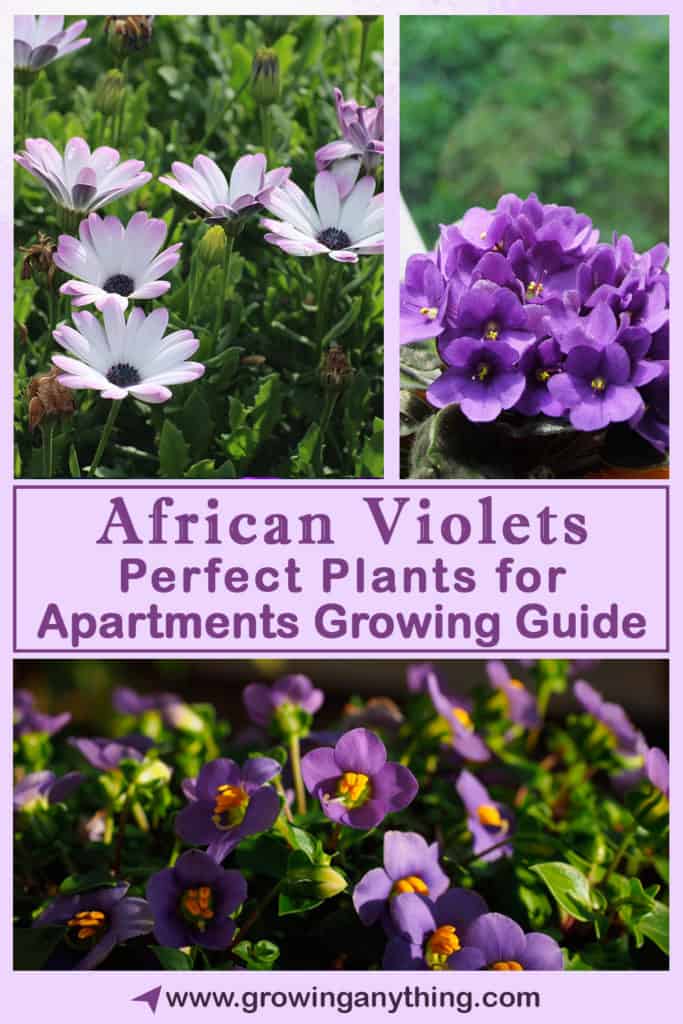All About African Violets
African violets have unique fuzzy foliage and bright violet flowers. The plant is compact and doesn’t require complex maintenance. I also recommend African violets as a housewarming gift, and the plant will blend perfectly into every interior style.
In this article, you will learn the most important aspects of growing and caring for this indoor plant. That includes potting, caring, and propagating.
I will also cover the varieties of African violets and give you more tips on displaying your lovely flowers.
African violets grow in pots, and in some cultures represent the symbol of friendship, loyalty, and faithfulness! Therefore, African violets aren’t only decoration. These plants are a daily reminder of the good things in every home!
Keep reading to become an African violets expert!
What are African Violets?
African violets belong to the family Gesneriaceae, genus Streptocarpus. The plant is native to eastern tropical Africa, mostly Tanzania and Kenya.
In North America, African violets are strictly indoor plants because they require specific conditions to be grown outside.
There are several varieties of the plant, and they differ in flower color and overall size. You can recognize African violets by their leaves with fine hair, oval shape, and fleshy structure.
But, African violets are also known for their beautiful flowers. The plant has 3 cm large flowers with five petals. Flowers have an almost velvety texture and appear in clusters. One cluster can hold up to ten flowers on the slim stalks, peduncles.
Most indoor African violets come with violet flowers, but some native varieties can have purple, light blue, pinkish, or white flowers.
The plant got its name because it resembles Violet flowers that belong to the family Violaceae.
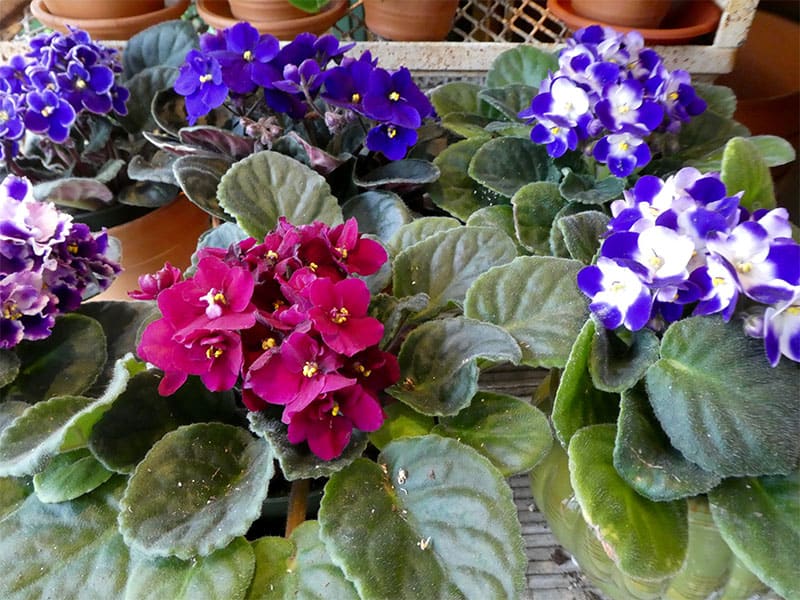
Did you Know?
African violets are so popular, and there is an organization dedicated to helping people grow these admirable indoor plants. African Violets Society of America (AVSA) exists for 75 years and provides support to enthusiasts.
They even hold an annual convention dedicated to these lovely flowers.
Their photo gallery is a stunning collection of the most beautiful African violets grown in America.
African Violets Sizes
African violets are usually divided by their maximum diameter size. There are four categories to which most varieties belong.
- Miniature – the diameter is less than 8 inches
- Semi-miniature – Grow between 8 and 12 inches in diameter
- Standard – Expected diameter is between 12 and 16 inches
- Large – The plant grows over 16 inches in diameter
How to Choose the Pot for African Violets?
You need to find the correct size pot for your African violets. A wrong-size pot will affect the growth of your plant. So, the plant will be smaller with fewer flowers and flower buds.
To pick the appropriate size of the pot, you must know the size of the plant.
The African violets will grow the best in pots that are 1/3rd size of the plant diameter.
Moreover, African violets like well-draining soil, so you need to ensure enough drainage holes in the pot.
Refer to the table as a simple guide to choosing the pot for African violets.
| Plant size | Pot diameter | Drainage holes number |
| Miniature | 2-inch | 2-3 holes |
| Semi-miniature | 3-inch | 3-4 holes |
| Standard | 4-inch | 4-6 holes |
| Large | 6-inch | 6-8 holes |
Does Pot Material Matters?
Old-school gardeners grow African violets in plastic pots. The watering methods such as wicking or capillary matting work great, and the plastic pots are available in many shapes and sizes.
The only issue with plastic pot is the sharp rim that can damage the backside of the foliage. But, you can easily resolve the issue by choosing the pot with a rolled rim.
However, if you live in a hot climate, you might want to consider a clay pot, and it acts as a cooling device for the roots. Clay pots also have better evaporation.
Can you Plant African Violets Together in one Pot?
You can do it, but I don’t recommend doing that to get the best blooms. Because the plant spreads horizontally, it needs more space. If you plant two African violets in one pot, the leaves will get tangled, and the plants won’t produce many flowers.
However, if you want to mix two varieties of African violets, you can plant them in separate pots. Then place the pots in one larger container to make it look as they are planted together.
But, keep the plants in the container for only a short time, as that kind of display will affect their growth if applied for longer.
First Steps
Once you buy your African violets, you should repot them. Generally, the gardening centers keep plants in a dense potting mix, because it is easier for transport. But, African violets prefer loose soil, so you should repot the plant to a larger pot.
Potting African Violets
Once you have chosen the appropriate size pot, it is time for planting. In well-supplied gardening centers, you can find the potting mix created specifically for African violets. But, you can also use a standard potting mix as long as it has well-draining properties.
Amend the soil with organic matter and lose it up to get better results.
You can transplant the violets in spring or fall, but I recommend spring. Just grab the plant and transfer it from the current pot to the new pot. Be gentle and try not to damage the roots and that is all! Fill the pot with soil and water it at the base of the plant.
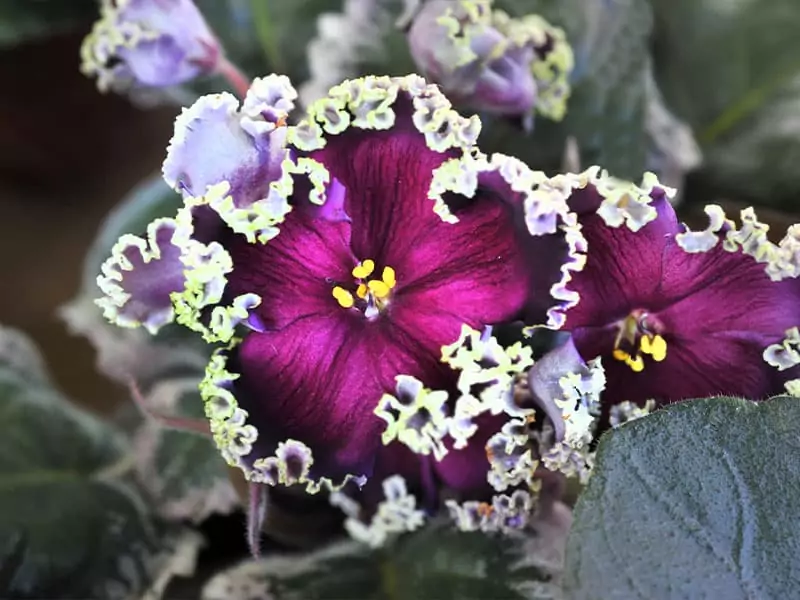
Caring for African Violets
African violets don’t require a lot of maintenance. Check the following guide to learn how to care for your violets.
Watering
Most people wonder how much water is enough for African violets. The easiest way to check if the plants need more water is to check the topsoil layer. It should be completely dry between two watering sessions.
If you overwater the plant, it can cause irreparable damage and kill the plant. The clay pots are a better choice for people who tend to overwater their plants because clay induces evaporation.
Remember, African violets like moist soil, but hate soggy. So, the well-draining soil and optimal watering is the key to successfully grow your African violets.
You can water the plant either from the top or bottom. But, avoid using too cold water, lukewarm will be better. Also, try not to water the foliage, because water on the foliage will leave spots.
If you decide to water from the bottom, give the plant time to take the water it needs, and throw the water leftover.
Light
African violets grow best in indirect indoor light. The plants need light to perform photosynthesis. If the plant doesn’t get enough light, it will starve and won’t produce flowers. The foliage will turn yellow.
On the other hand, if the plant is exposed to too much light, you will notice brown spots on blooms and foliage, or in simple words – sunburns.
Therefore, the best location for optimal exposure to sunlight is a window on the west or south part of the house. You can use sheer curtains to filter the light.
Because the duration of the sunlight varies across the seasons, you can help your plant by rotating it. During the winter, let the plant receive more light, and during summer, protect it.
Also, African violets need eight hours of complete darkness to produce flowers. During long days, you can cover the plant or put it away from the window.
Temperature
African violets are no different than people when it comes to preferred temperature and humidity conditions.
If you feel comfortable in the room where you keep your African violets, the plants will love it too.
The ideal temperature for African violets is around 70 degrees Fahrenheit. They can suffer if the temperature drops below 60 or go over 80 degrees. The slight changes in temperature between day and night won’t damage the plants, but extreme temperatures may kill the plant.
When the leaves seem dry or wilted, and the flowers lean forward, the room temperature is too high for African violets. Also, water the plant more frequently if you cannot affect the temperature in the room.
On the other hand, if the room is too cold, you can notice dark and mushy tissue on the foliage. Remove the affected tissue and move the plant to the warm room. At that point, you should stop watering and fertilizing the plant.
Instead, try to keep high humidity in the room to help the plant recover faster.
You can use the bag method to have high humidity around the plant. Cover the plant with a bag, and close it. Observe the plant over the next couple of days, and you will see changes. You can keep the plant in the bag for a week for a full recovery.
What about Warming Mats?
If your house is too cool and you prefer colder temperatures, you can use a warming mat to help your plant. It will ensure that the plant gets enough warmth for continuous growth. Moreover, you can put the plant upper, and avoid placing it on the floor.
Humidity
Humidity is important to factor for growing African violets. African violets grow in their native habitat with humidity between 70 and 80 percent.
Considering that it is challenging and unhealthy for people to keep the humidity that high, you can keep it between 50 and 60 percent.
If the air is dry, the African violet plant will lose its ability to absorb water and it will make the plant look dry and affect the growth.
Luckily, there are several methods to increase the humidity around your plants.
Group the plants together and that will increase the humidity around the plants by up to 15 percent. Make sure to leave space for air circulation, to prevent fungi development.
Some people also use the self-watering device. It uses capillary matting to improve the humidity. Lastly, you can use a humidifier around your plants. Some people use it over the winter because the air gets too dry and uncomfortable for plants and people.
Grooming
African violets need grooming to produce flowers for longer. You have to remove flowers as they mature and fade. Once the last flower on the stem fades away, it is best to remove the entire stem.
Also, if your plant suffers from any condition, you should remove the damaged leaves.
Additionally, you can use shears to create the desired shape and look of your plant.
Repotting
You can achieve the best results if you repot once or twice per year. The African violets can live up to 50 years if repotted regularly. Just increase the size of the pot when the plant is actively growing.
The idea behind regular repotting is to bury the exposed stems. It will also refresh the potting mix, as, over time, it can become too acidic, and affect plant growth.
You can repot your plants when you notice the primary stem poking under the lower foliage rows. I also recommend putting the plant into the high-humidity area for a couple of days to give it time to adjust to new soil properties.
Fertilizer
You can use standard nitrogen, phosphorus, and potassium fertilizer to ensure healthy growth. Some fertilizers have calcium and magnesium. But, if the water in your area is rich in these minerals, the plants will get their supplies through watering.
People who use the rain, reverse osmosis or distilled water might need to add the minerals to their plants.
Phosphorus, nitrogen, potassium, calcium, and magnesium are called macronutrients.
But, some fertilizers also offer micronutrients. Their purpose is to change the pH of the soil and make it comfortable for the plant. For example, you can use a fertilizer with sulfur to lower the pH level to 6 or 7. But, don’t use it if the soil pH level is below six and too acidic.
Generally, I recommend using balanced fertilizer when the plant is actively growing, and high-phosphorus formula just before the winter.
Propagation – Step by Step Guide
African violets are so delightful household plants and you probably want to get more of them because they look better in clusters.
The best tip for propagating African violets is to start with more cutting than you need. Not all the cuttings will grow into adult plants, so it is better to have more plants to work with.
Here is a list of steps to follow to ensure maximum success when propagating African violets.
1. Start by picking the healthiest foliage. It is usually located in the middle of the bush and makes cuttings just the stem base. Don’t leave parts of the stem on the primary plant, as it can damage it.
2. Next, shorten every cutting to the one-inch size.
3. Prepare small containers. Water the soil and poke the hole on the top layer where you will place the cutting.
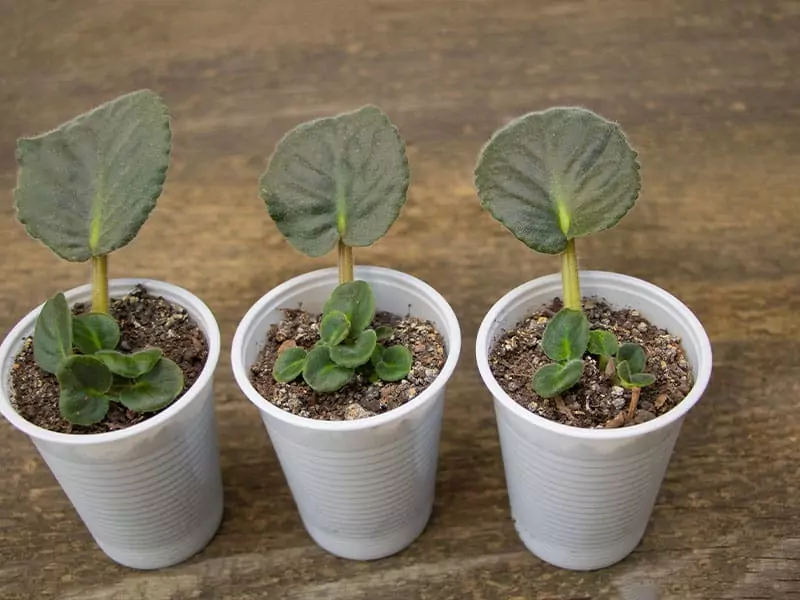
4. You can use rooting hormone if you want, but remember to tap the excess products of the cutting.
5. Put the stem gently in the hole in the soil, and pat the soil.
6. Often, you will have to support the leaf with something.
7. Find the appropriate place with plenty of light for your small containers, but make sure the location isn’t too warm.
8. Let your cutting grow at their pace, and transplant them when you notice they develop leaflets.
Pests and Diseases
You have better chances to prevent issues with African violets than to cure them. The first thing to do is buy a healthy plant and care for it properly. It will lower the chances of diseases and make the plant resilient.
However, several issues can happen with African violets, despite appropriate care.
Cyclamen Mites
Cyclamen mites are tricky and unfortunately most common pests that attack African violets. In most cases, you will have to destroy the infected plants. They feed on the tissue on young leaves and flowers.
If the plant is under the attack of cyclamen mites, you will notice darkened and deformed foliage, stunted growth with black buds. Sometimes, there are white bumps on the leaves.
Springtails
Springtails can happen if the soil is soggy or you amend it with too much organic matter. Even though they won’t harm the plant too much, you can let the soil dry completely. Springtails chew the plant roots, so they can affect the plant’s overall health and resilience to other pests and diseases.
Botrytis Blight
Botrytis Blight is a common fungal disease that affects African violets. It is a result of poor growing conditions and high humidity levels.
You can see grey mold spots on flowers, foliage, and even dead leaves. Regular repotting serves as prevention against Botrytis Blight. Also, you have to clean the pots and saucers used before and after grooming.
African Violets Species
Some African violets species grow wild in Tanzania and Kenya. However, their natural habitat has been endangered due to growing agriculture. The species go under the name of Ionantha, and modern varieties are mostly hybrids of the same and different species.
Top 27 Varieties of African Violets to Consider for Your Home
There are numerous varieties of African violets available today, and new ones are discovered daily. They differ in foliage, shape, size, flower colors.
Growing conditions for each variety are similar – well-draining soil and filtered lights, but some require more maintenance than the other.
Let’s have an overview of the most popular varieties of African violets.
Diamond Tiffany
Diamond tiffany features beautifully ruffled flowers. The flowers are light yellow with green lines on the outside corners of the petals.
First Kiss Blush
The variety with an interesting First Kiss Blush name has gentle, soft pink flowers with traces of purple on the edges and across the petals. It has a unique look and yellow center, which contributes to the pleasant look.
Lonestar Twilight
Lonestar twilight variety has white flowers with violet color across the edges. The center is yellow, and the foliage seems hairier than in some other alternatives.
Summer Twilight
Summer twilight has traditional African violet looks. The flowers have purple petals with white lines. The centers are yellow, which makes a stunning contrast to violet flowers and deep green foliage.
Julia
Julia’s flowers have almost a circle shape. Ruffled petals are soft and violet, with darker edges. It gives them a reverse ombre effect and a unique appearance.
Zephyr
Zephyr has a delicate pink flower with irregular white coloration. It has fewer petals than some other variations with small yellow centers.
Aroma of Summer
The aroma of summer variety has a compelling scent and distinctive appearance. The blooms are pink with white color on each petal beginning. The yellow seeds, pink-white combination, and dark green foliage make the Aroma of the summer possibly the most beautiful African violets variety.
Valeska Viol
Valeska viol variation features two-colored petals. It is common for one flower to have several violet petals and all-white petals. The centers are light yellow.
Cajun’s Simply Elegant
It is a beautiful variation with large green foliage with pinkish edges that slowly take over every leaf. The flowers are small and pink, and the plant grows 16 inches max in diameter max.
Silver Romance
Silver romance features colors you will unlikely see in nature. The variations have pastel pink flowers, but the edges are what make this variation stand out. Each petal has its edges lighted with specific green or white shade.
The pastel combination of rose and green is unique and beautiful in all home settings!
High School Sweetheart
This variation is similar to the previous one, but the pink petals are much richer in colors. The petals have similar edges and are a bit more ruffled.
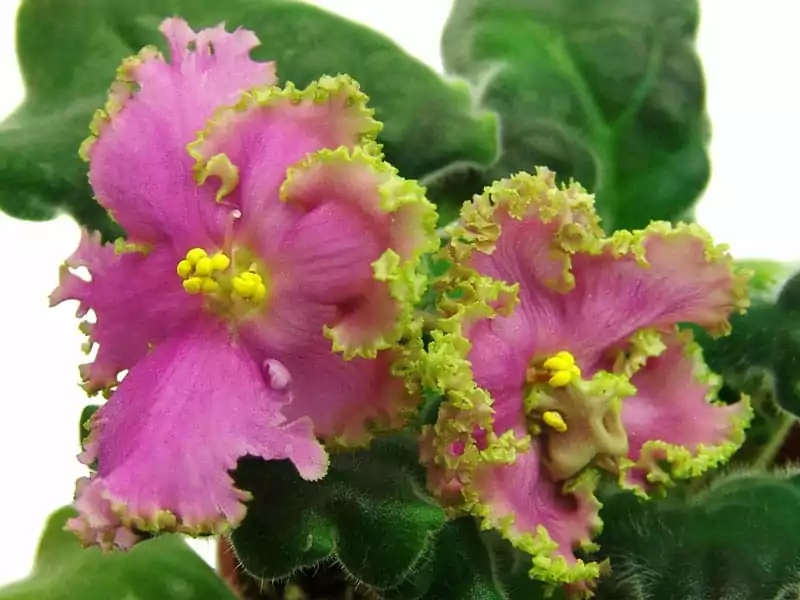
Linda Darnell
Linda Darnell variety of African violets grows up to 8 inches in diameter. It has small purple flowers and glossy foliage.
Shamahanskaya Queen
This variety is the queen of all of them. It has small flowers with unique pink-purple-white flowers.
The petals feature white lace on the edges, which gives the flowers an outstanding appearance.
PT Shah-Shahriyar
It is a variety of unusual looks. The deep purple flowers are ruffled and twisted. The petals have different shades on the edges, and the centers are so small and yellow, and hardly visible from the rich bloom.
Lyon’s Lavender Magic
This variety is large and has lavender-shade flowers with quilted foliage. It is easy to grow and produces many flowers.
RD’s Gleam
RD’s Gleam has almost horizontal flowers with five large pink petals. The flowers are open and display multiple yellow seeds.
LE Vega
It is a variety with wide-open burgundy flowers. The yellow seeds in the center compliment the warm shade of the petals.
Mac’s Strawberry Sundae
It is a variety of coral-red flowers and velvety foliage. When groomed well, it grows to an almost perfect pyramidal shape.
RS Vicomte
The Vicomte flowers are fluffy and violet with soft white borders. As the flowers mature, the violet color looks like an eclectic blue.
Candy Fountain
Candy fountain is an excellent choice if you want to grow African violets in hanging pots. It has pink blooms with light green foliage.
World to Your Home
The elegant variation World to your home has dark green, almost grey foliage, and brilliant white flowers. The flowers have more petals than other varieties and these slightly lean forward. It looks sophisticated in modern apartments.
Little Maya
The Little Maya has stunning heart-shaped flowers in bright pink shade. The flowers have a black back and need at least 8 hours of darkness to develop true color.
RM Visavi
The Visavi has distinct petals that are almost red or burgundy. The edges are white, and each petal has a unique shades combination.
Strawberry Wave
Soft pink petals look like they are sprinkled with unique violet paint. The spotting slowly fades towards the yellow center of the flower.
Gold of Scythians
The next variety is gentle and charming, with its white flowers with traces of pink color. The yellow centers are hidden between rich petals in a pinkish shade.
Milky Way Trial
This hybrid has foliage in the shape of a heart. It grows to a bushy shape with small white flowers and requires frequent grooming.
Peacock
Peacock variety has dark violet flowers with discreet purple and pink lines and dots on the petals. The yellow center makes a beautiful combination with violet flowers.
How to Arrange African Violets?
African violets are lovely plants, but if you have several pots, you might don’t know how to arrange them.
Here are a few ideas for the most delightful displays.
Colorful Centerpiece on the Tabletop
You can get a 1-inch deep tray that is large enough to accommodate several pots of African violets. Put the artificial grass on the bottom of the tray, and arrange the pots in a single line in the middle. You can use it as a centerpiece on the table.
Colorful Basket
You will need a larger, preferably round basket and a candle. The basket method works better if you own miniature African violets.
Place the candle in the middle of the basket, and surround it with small pots of African violets.
Corner Shelf
You can also make a corner shelf near the window and display your colorful African violets there. If you own standard varieties, you can place one pot per shelf, or mix several miniature plants on each shelf.
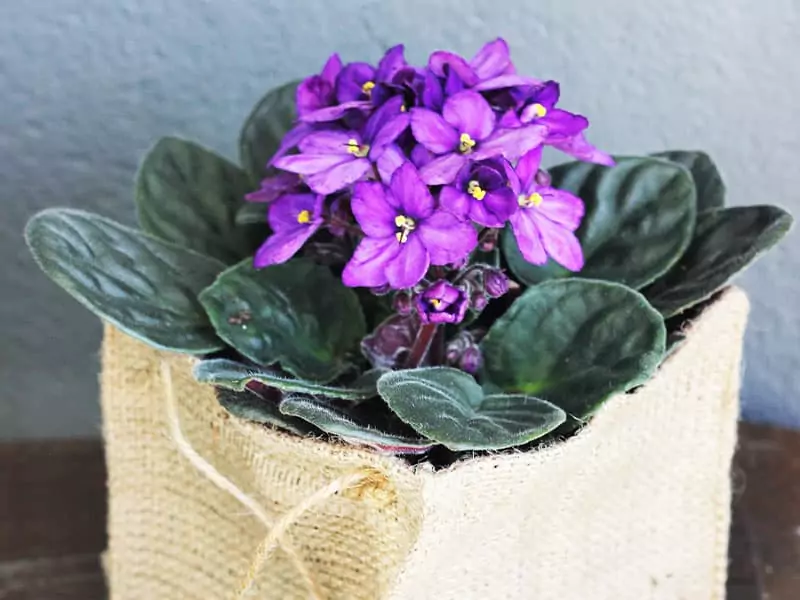
African Violets – Your Favorite Apartment Flowers
African violets are a beautiful flowering plant that has unique foliage and charming flowers. There are so many varieties on the market, and the plant isn’t challenging to grow and care for. After all, so many families have these plants in their homes as part of the regular decoration!
All they need is a bit of love to choose a proper location, learning the optimal amount of water, and more simple caring activities such as grooming and repotting. Even if you aren’t skillful in growing indoor plants, you have high chances for success!
Whichever variety you choose, it will significantly improve the look of your apartment and make it feel like home!
If you enjoyed my comprehensive article about African violets, show your love by liking and sharing it with your friends and family. And tell me, which variety would you choose for your home?
